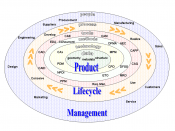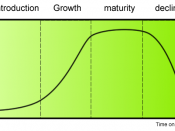INTRODUCTIONThe product cycle concept states that all products have a life span. Since the desirability and sales of a product changes at different stages of a product's life, product concept and strategy always need constant revision. Product cycle can apply to both a category of a product or a brand and underlines most business planning models because of sales and profitability. It has a number of stages which are usually characterised by the amount of revenue brought in by the product at certain stages. All products have varying life spans depending on several factors; some have shorter spans like months whereas some items last a lifetime such as petrol fueled vehicles. In any event, when a business decides on putting out a new product the concept of the product cycle is of utmost importance to planning and budgeting. The product cycle concept suggests that all products go through these phases:DEVELOPMENT STAGEAt the development stage, there is no revenue as this is the incubation stage of the product.
The technical feasibility of manufacturing the product at an acceptable cost should be thoroughly examined. Excessive market research is factored into planning as well as concept development and testing. Plans will also be put in place for copyright, patents etc. and firms will have to substantiate a budget for this as well as a time frame as to when the product is expected to be ready for the market. The management process is:Test MarketingLimited market testing is done to determine how potential customers react to the product. This allows management to evaluate alternative strategies and assess how well the various aspects of the marketing mix fit together.
CommercializationThe decision to market a product.
The last of the process is ordering production materials and equipment, starting productions, building inventories then introducing the product.
INTRODUCTION STAGEAn example of a product currently in its introduction stage is new soft drink 'Classics' launched in March 2008 by Schweppes.
At the introduction stage costs for the firm are high as profits are non existent or very little due to low sales and high distribution and promotion costs. Promotional costs are high as the firm concentrates a lot of effort on persuading, informing and influencing market users to try the product to build and increase demand for the product. A strategic and tactical plan is put in place with a launch strategy and product launch.
The strategic plan looks at competitive stance, i.e. current market situation, similar products if any and helps the company plan market positioning. A competitive strategy analyses the strengths, weakness; opportunities and threats (SWOT) to the product, a marketing strategy to define the necessary steps needed to achieve the company's objective for the product and to select ways of attracting and approaching customers like targeting select groups is planned.
A marketing plan is integral to positioning the product and the company uniquely and successfully in the market and consist consumer analysis, market analysis, company analysis, marketing strategy and sales approach.
Tactical planning includes branding. The company considers whether to create a new brand, extend a brand or launch the product under an existing brand. Schweppes have chosen the latter.
A pricing plan is created where pricing is explored tactically based on target group, geographical location, development costs etc. Some companies use a skim price to recover development and promotional costs and to take advantage of the market before it becomes over saturated. Other companies may use a penetration pricing strategy by using low price to encourage prompt sales and gain market share quickly.
A distribution plan is also created.
GROWTH STAGEThe growth stage is a period of rapid revenue gain, sales have increased and the product is now accepted. More retailers will carry the product so the distribution plan needs to be reviewed as new distribution channels need to be added to meet increased demand. The promotional plan will need review too as advertising will need to be increased to build brand as more competitors would have entered the market so this is the ideal time to promote to a broader audience. The firm will have to plan ways of standing out from the competition like improving on the product by adding different configurations, styling, etc and also plan to enter different segments of the market. The pricing plan may not need to be reviewed depending on sales but during the early growth stage normally remains high. It is only at the latter part of the middle growth stage and at the last growth stage that prices may need to be lowered due to intense competition so the firm reduces to capture additional customers. The budget for costs during this stage will need to be considered because although profits start to be made, product improvement, distribution and promotion costs still remain high.
The accountancy market in the UK is an example of a service that has been experiencing a strong growth phase throughout 2005 and growth is expected to continue up until 2009.
MATURITY STAGEThe maturity stage is where the most profit comes in of all the stages and is the most successful part of a product's life. In the early maturity stage, sales continue to increase but do so at a slower pace. If the company has established itself as a brand leader, advertising expenses are reduced.
At the later part of the maturity stage, increased competition causes the market to be over run with similar products and differentiation is hard. The firm will look at its product plan and find more ways of modifying the product.
The promotion plan is reviewed as the firm plans ways of getting customers to switch from competitors, increase usage per customer and attracting new users. Sales promotions to encourage retailers to offer the product more shelf space etc. may be used. Brand power and incentives for loyal customers and new customers is used.
Distribution plan is modified as it becomes more intense looking new distribution channels and offering incentives to resellers.
Pricing plan is amended to reflect the state of the market as prices cannot remain high due to competition.
The primary goal during the maturity stage is to maintain market share and extend the life cycle of the product. Resurgence tactics such as changing how customers use the product, finding new markets not previously targeted etc.
Some examples of products in the maturity phase are ipods, personal computers etc.
DECLINE STAGENo matter how much effort is put in however, there often comes a time when a product is no longer in demand. Sales start to fall and can be slow or quick as the product becomes obsolete when customer's taste change. In some cases, a product might have developed brand loyalty and profit may be maintained longer but as time goes on, unit costs might prove too high for the decline in demand and profit can no longer be maintained. This stage can last a long while like maturity stage.
The firm reviews its strategic plan looking at the competitive stance due to a lot of companies leaving the market. The firm can apply a marketing exit strategy called a 'milking' strategy where it plans to get the most out of the product in terms of sales without spending any more money on the product.
With stagnant sales, distributors would have started removing the product so the firm modifies its distribution plan and removes its products from unprofitable outlets. The firm can plan to sell online or through other untraditional methods.
Promotion is now less intense for advertising the product; an occasional reminder might be sent to loyal customers at little cost. If there are future products in the pipeline, the brand might still be promoted.
The firm may plan to keep prices the same or even raise them because of the niche in the market due to competitors dropping out or plan to reduce the price to liquidate inventory of discontinued products.
There would be no plans to improve the product any further and some models would have been discontinued so the product plan would be static. When a product reaches its ultimate decline, any planning and budgeting for that product would have now ended and the firm starts to focus on the development of a new product.
Some examples are vinyl records, walkmans etc, video cassettes etc.
CONCLUSIONFrom the above, we have seen how the product cycle concept serves as an instruction manual or marker to managers as to what measures are put in place in order to maximise profit and minimise loss at each stage of a product's life cycle. The concept is essential for business planning and budgeting in preparing, monitoring, manoeuvring and manipulating each stage of a product in relation to the company's objectives.
The importance of the concept of the product cycle to business planning and budgeting is then therefore that it works as a reliable and fundamental planning guide and monitoring tool for handling costs and budgets at each stage of a product and allows for adaptations to be processed and developed in accordance to challenges faced at each stage.
Sources of information / ResourcesZopounidis, C and Pardalos, P (1998) Managing in Uncertainty: Theory and Practice, p326-338Rink, D.R., Roden, D.M, Fox, H.W. (1999) Business Horizons, Volume 42, p.65-72Chernev, A. (2005) Essential Marketing Concepts and Frameworks, p. 66-89Business Essentials, (Supporting HND/HNC AND FOUNDATION DEGREES) Sept, 2007 1st edition, p.213-214Day, G. (1981) The product life cycle: Analysis and applications issues, Journal of Marketing, volume 45, Autumn 1981, p. 60-67Collins, D., The advantages of the product life cycle concept. Available from: , accessed August 23rd, 2008.



Understandable and clear
This essay is written in a clear manner. Easy to understand
0 out of 0 people found this comment useful.